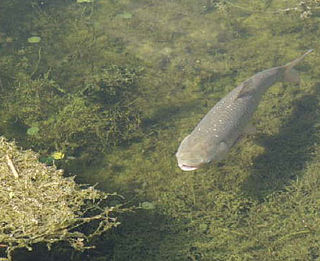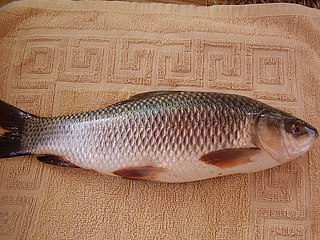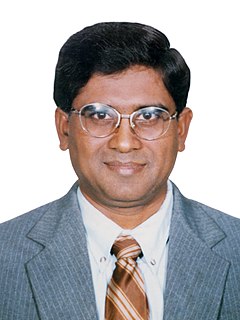See also
| This disambiguation page lists articles associated with the title Indian carp. If an internal link led you here, you may wish to change the link to point directly to the intended article. |
Indian carp or Indian major carp is a common name for several species of fish:
| This disambiguation page lists articles associated with the title Indian carp. If an internal link led you here, you may wish to change the link to point directly to the intended article. |

Carp are various species of oily freshwater fish from the family Cyprinidae, a very large group of fish native to Europe and Asia. While carp is consumed in many parts of the world, they are generally considered an invasive species in parts of Africa, Australia and most of the United States.

Cypriniformes is an order of ray-finned fish, including the carps, minnows, loaches, and relatives. This order contains 11-12, although some authorities have designated as many as 23, families over 400 genera, and more than 4,250 species, with new species being described every few months or so, and new genera being recognized frequently. They are most diverse in southeastern Asia, and are entirely absent from Australia and South America. At 112 years old, the longest-lived cypriniform fish documented is the bigmouth buffalo.

Several species of heavy-bodied cyprinid fishes are collectively known in the United States as Asian carp. Cyprinids from the Indian subcontinent—for example, catla and mrigal —are not included in this classification and are known collectively as "Indian carp". The Asian carp is considered an invasive species in the United States.

The rohu, rui, or roho labeo is a species of fish of the carp family, found in rivers in South Asia. It is a large omnivore and extensively used in aquaculture.

Catla, also known as the major South Asian carp, is an economically important South Asian freshwater fish in the carp family Cyprinidae. It is native to rivers and lakes in northern India, Bangladesh, Myanmar, Nepal, and Pakistan, but has also been introduced elsewhere in South Asia and is commonly farmed.

The Thamirabarani or Tamraparni or Porunai is a perennial river that originates from the Agastyarkoodam peak of Pothigai hills of the Western Ghats, above Papanasam in the Ambasamudram taluk. It flows through Tirunelveli and Thoothukudi districts of the Tamil Nadu state of southern India into the Gulf of Mannar. It was called the Tamraparni River in the pre-classical period, a name it lent to the island of Sri Lanka. The old Tamil name of the river is Porunai. From the source to sea, the river is about 128 kilometres (80 mi) long and is the only perennial river in Tamil Nadu. This river flows towards north direction initially. However, it changes to east direction later.

The bighead carp is a species of freshwater fish, one of several Asian carps. It is one of the most intensively exploited fishes in aquaculture, with an annual worldwide production of over three million tonnes in 2013, principally from China.

Bhimtal Lake is a lake in the town of Bhimtal, in the Indian state of Uttarakhand, with a masonry dam built in 1883 creating the storage facility. It is the largest lake in Kumaon region, known as the "lake district of India". The lake provides drinking water supply and supports aquaculture with variety of fish species. There is an island at the centre of the lake which has been developed as a tourist attraction and has an aquarium.

The silver carp is a species of freshwater cyprinid fish, a variety of Asian carp native to China and eastern Siberia. Although a threatened species in its natural habitat, it has long been cultivated in China. By weight more silver carp are produced worldwide in aquaculture than any other species of fish except for the grass carp. Silver carp are usually farmed in polyculture with other Asian carp, or sometimes with catla or other fish species.

Labeo is a genus of carps in the family Cyprinidae. They are found in freshwater habitats in the tropics and subtropics of Africa and Asia.

Maharana Pratap Sagar, in India, also known as Pong Reservoir or Pong Dam Lake was created in 1975, by building the highest earthfill dam in India on the Beas River in the wetland zone of the Siwalik Hills of the Dehra Gopipur Division Kangra district of the state of Himachal Pradesh. Town of Gopipur is submerged in the reservoir, many families were displaced while flooding of reservoir. Named in the honour of Maharana Pratap (1540–1597), the reservoir or the lake is a well-known wildlife sanctuary and one of the 27 international wetland sites declared in India by the Ramsar Convention. The reservoir covers an area of 24,529 hectares, and the wetlands portion is 15,662 hectares.

Rawal Lake in Pakistan is an artificial reservoir that provides the water needs for the cities of Rawalpindi and Islamabad. Korang River along with some other small streams coming from Margalla Hills have been set to form this artificial lake which covers an area of 8.8 km². Korang River is the outlet stream of Rawal Dam. Rawal Lake is located within an isolated section of the Village Malpur, Bani Gala and Margalla Hills National Park.

Fishing in India is a major industry employing 14.5 million people. India ranks second in aquaculture and third in fisheries production. Fisheries contributes to 1.07% of the Total GDP of India. According to the National Fisheries Development Board the Fisheries Industry generates an export earnings of Rs 334.41 billion. According to the Food and Agriculture Organization (FAO) of the United Nations, fish production has increased more than tenfold since 1947 and doubled between 1990 and 2010.Each year, India celebrates July 10 as the National Fish Farmers day. Koyilandy harbour in Kerala is the largest fishing harbour in Asia. It has the longest breakwater.

The fishing industry in the land-locked country of Laos is a major source of sustenance and food security to its people dwelling near rivers, reservoirs and ponds. Apart from wild capture fisheries, which is a major component of fish production, aquaculture and stocking are significant developments in the country. Historically, fishing activity was recorded in writings on the gate and walls of the Wat Xieng Thong in Luang Prabang dated 1560. For many Laotians, freshwater fish are the principal source of protein. The percentage of people involved in regular fishing activity is very small, only near major rivers or reservoirs, as for most of the fishers it is a part-time activity.

The mrigal carp, also known as the white carp, is a species of ray-finned fish in the carp family. Native to streams and rivers in India, the only surviving wild population is in the Cauvery River, leading to its IUCN rating as vulnerable. It is widely aquafarmed and introduced populations exist outside its native range. It reaches a maximum length of 1 m (3.3 ft). This species and Cirrhinus mrigala are considered distinct.

Fishery and fishing industry plays a significant part in the national economy of Pakistan. With a coastline of about 814 km, Pakistan has enough fishery resources that remain to be developed. Most of the population of the coastal areas of Sindh and Balochistan depends on fisheries for livelihood. It is also a major source of export earning.

Vishwa Gopal Jhingran (1919–1991) was an Indian zoologist and aquaculture scientist, known for the introduction of a composite fish culture technique by name, aquaplosion. He was a recipient of the fourth highest Indian civilian award of Padma Shri from the Government of India in 1977.

Mudnakudu Channabasappa Nandeesha was a development researcher, innovative aquaculture development worker and educator. He is recognized for making critical contributions to the rapid growth of aquaculture by applying research to key bottlenecks to fish production. In India, he conducted successful pioneering field tests of Ovaprim, an ovulating agent, under different agro-climatic conditions to help remove a critical early barrier for freshwater fish breeding. His significant scientific contributions include simplified breeding technology for cyprinids and development of feeds and feeding techniques appropriate to rural aquaculture, and helping improve and spread the practices of small scale fish farming at a time when most attention was on large scale producers. He wrote a regular and widely acclaimed column in Network of Aquaculture Centers in Asia-Pacific (NACA) Aquaculture Asia magazine on farmer innovations in aquaculture. He was described as an "ambassador for aquaculture" and was especially noted for promoting aquaculture for the disadvantaged poor households and women. Along with Michael New, in 2003 he was a founding member of the not-for-profit organisation, Aquaculture without Frontiers. While encouraging poor people to take up aquaculture, he was also a pioneer in promoting equity for women, who had been neglected in the aquaculture boom. Throughout his career, he was in the forefront of initiatives to upgrade the professionalism of fisheries and aquaculture experts, and inspired peers and students in critical new directions.